Effects of Wavy Leading-Edge Protuberance on Hydrofoil Performance and Its Flow Mechanism
Abstract
:1. Introduction
2. Numerical Models
2.1. Governing Equations and Turbulence Model
2.2. Cavitaiton Model
3. Numerical Setup and Solution Details
3.1. Hydrofoil Geometry
3.2. Mesh Layout and Solution Setup
4. Results and Discussion
4.1. Non-Cavitating Flow
4.2. Cloud Cavitation Evolution
4.3. Interactions between Streamwise Vortices and Cavitation
4.4. One Dimensional Analysis Method of Cavitating Flow Instability
5. Conclusions
Author Contributions
Funding
Institutional Review Board Statement
Informed Consent Statement
Data Availability Statement
Conflicts of Interest
Nomenclature
| Re | Reynolds number; |
| AOA | angle of attack; |
| mixture’s mass density, kg·m−3; | |
| velocity component in the i direction, m/s; | |
| p | local pressure, Pa; |
| liquid density, kg·m−3; | |
| vapor density, kg·m−3; | |
| turbulent viscosity, Pa·s; | |
| vapor volume fraction; | |
| E | element energy; |
| λ | heat conductivity coefficient; |
| T | temperature; |
| h | enthalpy component; |
| J | diffusion flux component; |
| τ | viscous stress tensor; |
| viscous dissipation term; | |
| turbulence scale; | |
| volume of the cell; | |
| typical grid size; | |
| shielding function coefficient; | |
| Sr | strain rate |
| αnuc | nucleation volume fraction; |
| Rb | radius of a nucleation site; |
| Cevap | evaporation coefficient; |
| Ccond | condensation coefficient; |
| C | chord length, m; |
| L | protuberance wavelength, m; |
| Am | protuberance amplitude, m; |
| inlet velocity, m/s; | |
| Pout | outlet pressure, Pa; |
| σ | cavitation number; |
| time step size, s; | |
| Cl | lift coefficient; |
| Cd | drag coefficient; |
| Cp | pressure coefficient. |
References
- Arai, H.; Doi, Y.; Nakashima, T.; Mutsuda, H. A Study on Stall Delay by Various Wavy Leading Edges. J. Aero Aqua Bio-Mech. 2010, 1, 18–23. [Google Scholar] [CrossRef] [Green Version]
- Woodward, B.L.; Winn, J.P.; Fish, F.E. Morphological specializations of baleen whales associated with hydrodynamic performance and ecological niche. J. Morphol. 2006, 267, 1284–1294. [Google Scholar] [CrossRef] [PubMed]
- Bushnell, D.M.; Moore, K.J. Drag Reduction in Nature. Annu. Rev. Fluid Mech. 1991, 23, 65–79. [Google Scholar] [CrossRef]
- Miklosovic, D.S.; Murray, M.M.; Howle, L.E. Experimental Evaluation of Sinusoidal Leading Edges. J. Aircr. 2007, 44, 1404–1408. [Google Scholar] [CrossRef]
- Fish, F.E.; Battle, J.M. Hydrodynamic design of the humpback whale flipper. J. Morphol. 1995, 225, 51–60. [Google Scholar] [CrossRef] [PubMed]
- Fish, F.; Lauder, G. Passive and active flow control by swimming fishes and mammals. Annu. Rev. Fluid Mech. 2006, 38, 193–224. [Google Scholar] [CrossRef] [Green Version]
- Miklosovic, D.S.; Murray, M.M.; E Howle, L.; E Fish, F. Leading-edge tubercles delay stall on humpback whale (Megaptera novaeangliae) flippers. Phys. Fluids 2004, 16, L39–L42. [Google Scholar] [CrossRef] [Green Version]
- Pedro, H.; Kobayashi, M. Numerical study of stall delay on humpback whale flippers. In Proceedings of the 46th AIAA Aerospace Sciences Meeting and Exhibit, Reno, NV, USA, 7–10 January 2008; p. 0584. [Google Scholar]
- Johari, H.; Henoch, C.; Custodio, D.; Levshin, A. Effects of Leading-Edge Protuberances on Airfoil Performance. AIAA J. 2007, 45, 2634–2642. [Google Scholar] [CrossRef]
- Hansen, K.; Kelso, R.M.; Dally, B. Performance Variations of Leading-Edge Tubercles for Distinct Airfoil Profiles. AIAA J. 2011, 49, 185–194. [Google Scholar] [CrossRef]
- Wei, Z.; New, T.; Cui, Y. An experimental study on flow separation control of hydrofoils with leading-edge tubercles at low Reynolds number. Ocean Eng. 2015, 108, 336–349. [Google Scholar] [CrossRef]
- Rostamzadeh, N.; Hansen, K.; Kelso, R.M.; Dally, B.B. The formation mechanism and impact of streamwise vortices on NACA 0021 airfoil’s performance with undulating leading edge modification. Phys. Fluids 2014, 26, 107101. [Google Scholar] [CrossRef]
- Hansen, K.L.; Rostamzadeh, N.; Kelso, R.M.; Dally, B.B. Evolution of the streamwise vortices generated between leading edge tubercles. J. Fluid Mech. 2016, 788, 730–766. [Google Scholar] [CrossRef]
- Cai, C.; Zuo, Z.; Maeda, T.; Kamada, Y.; Li, Q.; Shimamoto, K.; Liu, S. Periodic and aperiodic flow patterns around an airfoil with leading-edge protuberances. Phys. Fluids 2017, 29, 115110. [Google Scholar] [CrossRef]
- Luo, X.-W.; Ji, B.; Tsujimoto, Y. A review of cavitation in hydraulic machinery. J. Hydrodyn. 2016, 28, 335–358. [Google Scholar] [CrossRef]
- Arndt, R.E.A. Cavitation in Fluid Machinery and Hydraulic Structures. Annu. Rev. Fluid Mech. 1981, 13, 273–326. [Google Scholar] [CrossRef]
- Rus, T.; Dular, M.; Širok, B.; Hočevar, M.; Kern, I. An Investigation of the Relationship between Acoustic Emission, Vibration, Noise, and Cavitation Structures on a Kaplan Turbine. J. Fluids Eng. 2007, 129, 1112–1122. [Google Scholar] [CrossRef]
- Weber, P.W.; Howle, L.E.; Murray, M.M. Lift, Drag, and Cavitation Onset on Rudders with Leading-edge Tubercles. Mar. Technol. SNAME News 2010, 47, 27–36. [Google Scholar] [CrossRef]
- Shi, W.; Atlar, M.; Rosli, R.; Aktas, B.; Norman, R. Cavitation observations and noise measurements of horizontal axis tidal turbines with biomimetic blade leading-edge designs. Ocean Eng. 2016, 121, 143–155. [Google Scholar] [CrossRef] [Green Version]
- Custodio, D.; Henoch, C.; Johari, H. Cavitation on hydrofoils with leading edge protuberances. Ocean Eng. 2018, 162, 196–208. [Google Scholar] [CrossRef]
- Emvin, P.; Davidson, L.; Coutier-Delgosha, O.; Reboud, J.L.; Delannoy, Y. Numerical simulation of the unsteady behaviour of cavitating flows. Int. J. Numer. Methods Fluids 1997, 24, 519–530. [Google Scholar] [CrossRef]
- Coutier-Delgosha, O.; Fortes-Patella, R.; Reboud, J.L. Evaluation of the Turbulence Model Influence on the Numerical Simulations of Unsteady Cavitation. J. Fluids Eng. 2003, 125, 38–45. [Google Scholar] [CrossRef] [Green Version]
- Johansen, S.T.; Wu, J.; Shyy, W. Filter-based unsteady RANS computations. Int. J. Heat Fluid Flow 2004, 25, 10–21. [Google Scholar] [CrossRef]
- Girimaji, S.S.; Jeong, E.; Srinivasan, R. Partially Averaged Navier-Stokes Method for Turbulence: Fixed Point Analysis and Comparison With Unsteady Partially Averaged Navier-Stokes. J. Appl. Mech. 2005, 73, 422–429. [Google Scholar] [CrossRef]
- Huang, B.; Wang, G.-Y.; Zhao, Y. Numerical simulation unsteady cloud cavitating flow with a filter-based density correction model. J. Hydrodyn. 2014, 26, 26–36. [Google Scholar] [CrossRef]
- Roohi, E.; Zahiri, A.P.; Pasandidehfard, M. Numerical simulation of cavitation around a two-dimensional hydrofoil using VOF method and LES turbulence model. Appl. Math. Model. 2013, 37, 6469–6488. [Google Scholar] [CrossRef]
- Liu, C.; Bu, W.; Xu, D.; Lei, Y.; Li, X. Application of Hybrid RANS/LES turbulence models in rotor-stator fluid machinery: A comparative study. Int. J. Numer. Methods Heat Fluid Flow 2017, 27. [Google Scholar] [CrossRef]
- Liu, C.; Yan, Q.; Wood, H.G. Numerical investigation of passive cavitation control using a slot on a three-dimensional hydrofoil. Int. J. Numer. Methods Heat Fluid Flow 2019, 30, 3585–3605. [Google Scholar] [CrossRef]
- Fish, F.E.; Weber, P.W.; Murray, M.M.; Howle, L.E. The Tubercles on Humpback Whales’ Flippers: Application of Bio-Inspired Technology. Integr. Comp. Biol. 2011, 51, 203–213. [Google Scholar] [CrossRef] [PubMed] [Green Version]
- Walters, D.K.; Bhushan, S.; Alam, M.F.; Thompson, D.S. Investigation of a Dynamic Hybrid RANS/LES Modelling Methodology for Finite-Volume CFD Simulations. Flow Turbul. Combust. 2013, 91, 643–667. [Google Scholar] [CrossRef]
- Menter, F.R. Two-equation eddy-viscosity turbulence models for engineering applications. AIAA J. 1994, 32, 1598–1605. [Google Scholar] [CrossRef] [Green Version]
- Germano, M.; Piomelli, U.; Moin, P.; Cabot, W.H. A dynamic subgrid-scale eddy viscosity model. Phys. Fluids A Fluid Dyn. 1991, 3, 1760–1765. [Google Scholar] [CrossRef] [Green Version]
- Zwart, P.; Gerber, A.G.; Belamri, T. A two-phase flow model for predicting cavitation dynamics. In Proceedings of the 5th International Conference on Multiphase Flow, Yokohama, Japan, 30 May–3 June 2004; p. 152. [Google Scholar]
- Morgut, M.; Nobile, E.; Bilus, I. Comparison of mass transfer models for the numerical prediction of sheet cavitation around a hydrofoil. Int. J. Multiph. Flow 2011, 37, 620–626. [Google Scholar] [CrossRef]
- Liu, J.; Yu, J.W.; Yang, Z.L.; He, Z.; Yuan, K.; Guo, Y.H.; Li, Y. Numerical investigation of shedding dynamics of cloud cavitation around 3D hydrofoil using different turbulence models. Eur. J. Mech. B-Fluids 2021, 85, 232–244. [Google Scholar] [CrossRef]
- Huang, B.; Young, Y.L.; Wang, G.Y.; Shyy, W. Combined experimental and computational investigation of unsteady structure of sheet/cloud cavitation. J. Fluids Eng. Trans. ASME 2013, 135, 071301. [Google Scholar] [CrossRef]
- Sagaut, P. Large Eddy Simulation for Incompressible Flows: An Introduction; Springer: New York, NY, USA, 2006. [Google Scholar]
- Ji, B.; Luo, X.W.; Arndt, R.E.A.; Peng, X.X.; Wu, Y.L. Large eddy simulation and theoretical investigations of the transient cavitating vortical flow structure around a NACA66 hydrofoil. Int. J. Multiph. Flow 2015, 68, 121–134. [Google Scholar] [CrossRef] [Green Version]
- Long, Y.; Long, X.P.; Ji, B.; Xing, T. Verification and validation of large eddy simulation of attached cavitating flow around a Clark-Y hydrofoil. Int. J. Multiph. Flow 2019, 115, 93–107. [Google Scholar] [CrossRef]
- Pendar, M.R.; Esmaeilifar, E.; Roohi, E. LES study of unsteady cavitation characteristics of a 3-D hydrofoil with wavy leading edge. Int. J. Multiph. Flow 2020, 132, 103415. [Google Scholar] [CrossRef]
- Lakshmipathy, S.; Girimaji, S.S. Partially averaged Navier–Stokes (PANS) method for turbulence simulations: Flow past a circular cylinder. J. Fluids Eng. Trans. ASME 2010, 132, 121202. [Google Scholar] [CrossRef]
- Celik, I.B.; Ghia, U.; Roache, P.J.; Freitas, C.J. Procedure for estimation and reporting of uncertainty due to discretization in CFD applications. J. Fluids Eng. Trans. ASME 2008, 130, 078001. [Google Scholar]
- Carr, L.W.; Mcalister, K.W.; M Cc Roskey, W.J. Analysis of the Development of Dynamic Stall Based on Oscillating Airfoil Experiments; NASA Technical Reports; Washington, DC, USA, 1977; Available online: https://www.semanticscholar.org/paper/Analysis-of-the-development-of-dynamic-stall-based-Carr-Mcalister/a08a1421e19170b8c93867efdd23781fbd5eb201#citing-papers (accessed on 10 October 2021).
- Zhang, M.M.; Wang, G.F.; Xu, J.Z. Experimental study of flow separation control on a low-Re airfoil using leading-edge protuberance method. Exp. Fluids 2014, 55, 1710. [Google Scholar] [CrossRef]
- Huang, B.; Zhao, Y.; Wang, G.Y. Large Eddy Simulation of turbulent vortex-cavitation interactions in transient sheet/cloud cavitating flows. Comput. Fluids 2014, 92, 113–124. [Google Scholar] [CrossRef]
- Li, Z.H.; Qian, Z.D.; Ji, B. Transient cavitating flow structure and acoustic analysis of a hydrofoil with whalelike wavy leading edge. Appl. Math. Modell. 2020, 85, 60–88. [Google Scholar] [CrossRef]
- Wang, C.C.; Wu, Q.; Huang, B.; Wang, G.Y. Numerical investigation of cavitation vortex dynamics in unsteady cavitating flow with shock wave propagation. Ocean Eng. 2018, 156, 424–434. [Google Scholar] [CrossRef]
- Chen, C.K.; Nicolet, C.; Yonezawa, K.; Farhat, M.; Avellan, F.; Tsujimoto, Y. One-dimensional analysis of full load draft tube surge. J. Fluids Eng. Trans. ASME 2008, 130, 041106. [Google Scholar] [CrossRef]
- Chen, C.K.; Nicolet, C.; Yonezawa, K.; Farhat, M.; Avellan, F.; Miyagawa, K.; Tsujimoto, Y. Experimental study and numerical simulation of cavity oscillation in a conical diffuser. Int. J. Fluid Mach. Syst. 2010, 3, 91–101. [Google Scholar] [CrossRef] [Green Version]
- Watanabe, S.; Yamaoka, W.; Furukawa, A. Unsteady lift and drag characteristics of cavitating Clark Y-11.7% hydrofoil. In Proceedings of the 27th IAHR Symposium on Hydraulic Machinery and Systems, Montreal, QC, Canada, 22–26 September 2014; p. 052009. [Google Scholar]
- Andrun, M.; Blagojević, B.; Bašić, J.; Klarin, B. Impact of CFD simulation parameters in prediction of ventilated flow on a surface-piercing hydrofoil. Ship Technol. Res. 2021, 68, 1–13. [Google Scholar] [CrossRef]

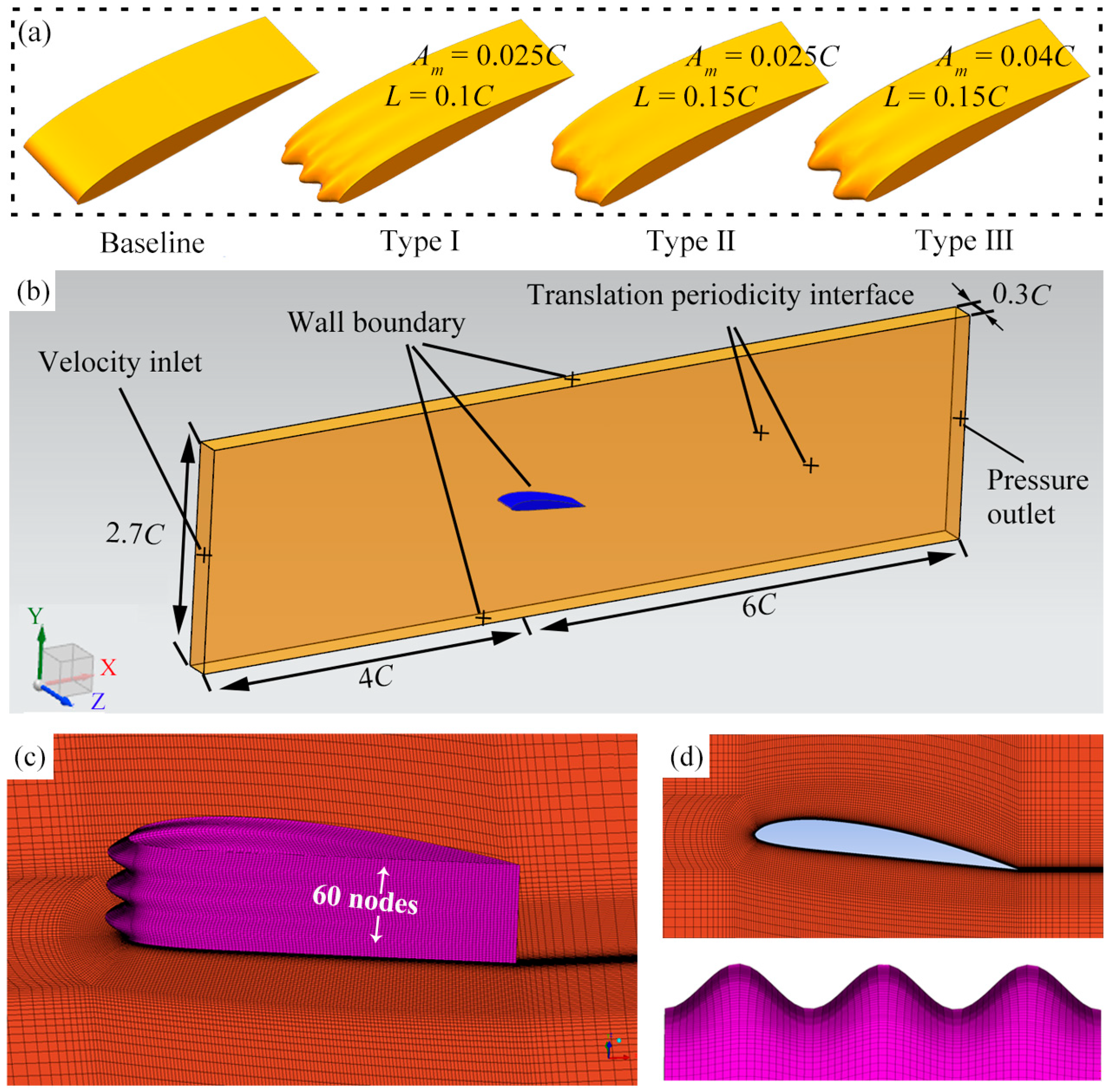

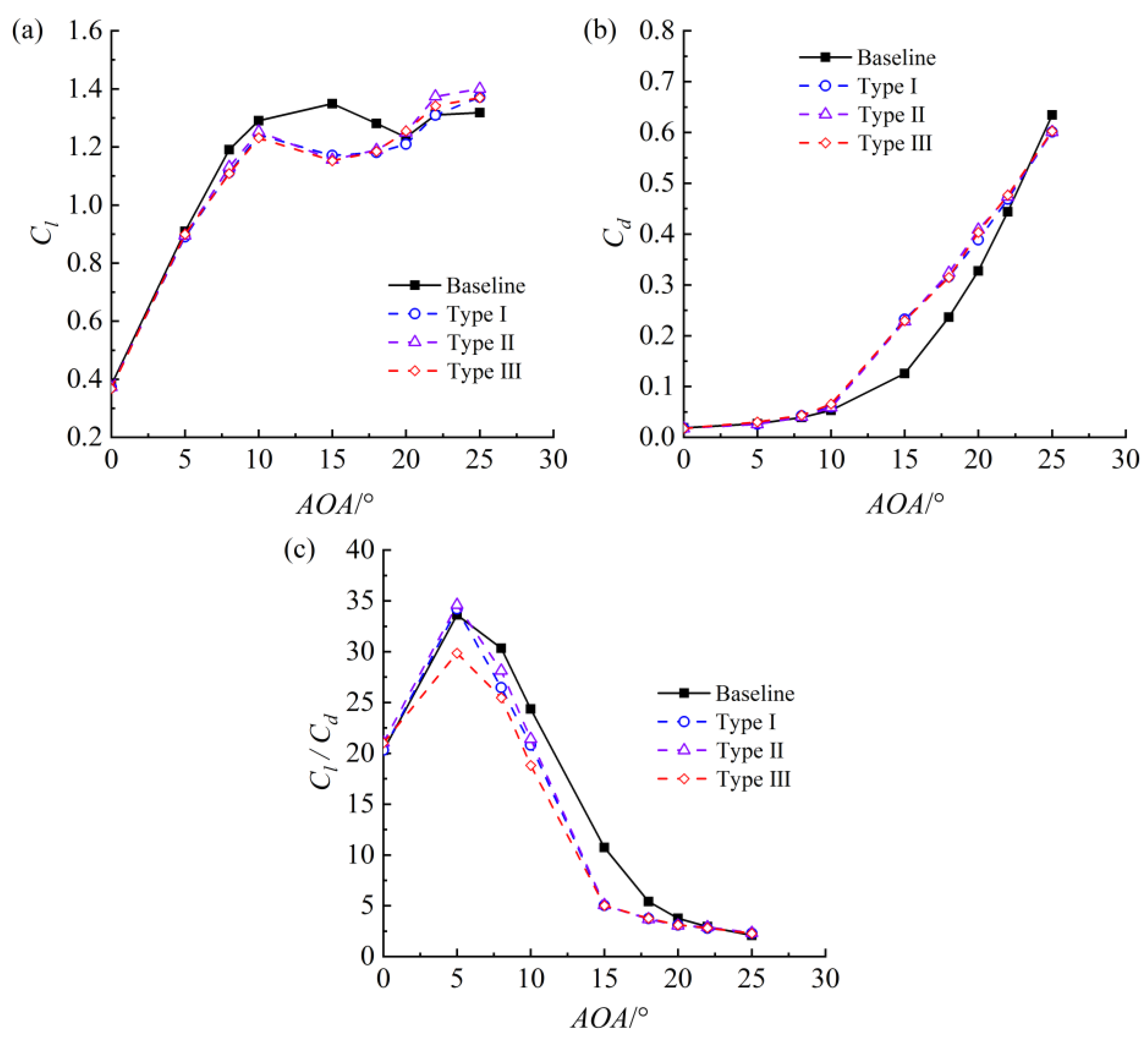

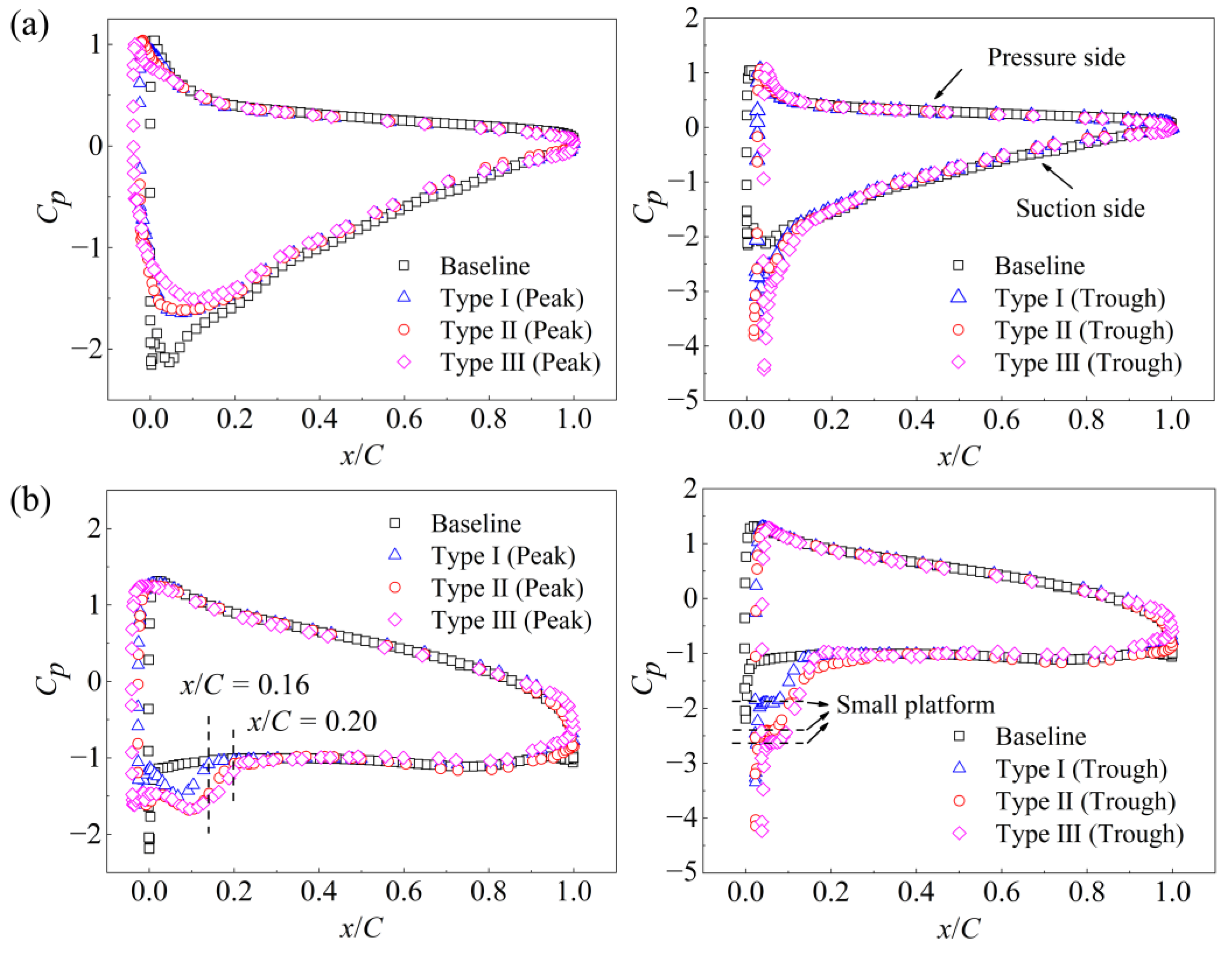
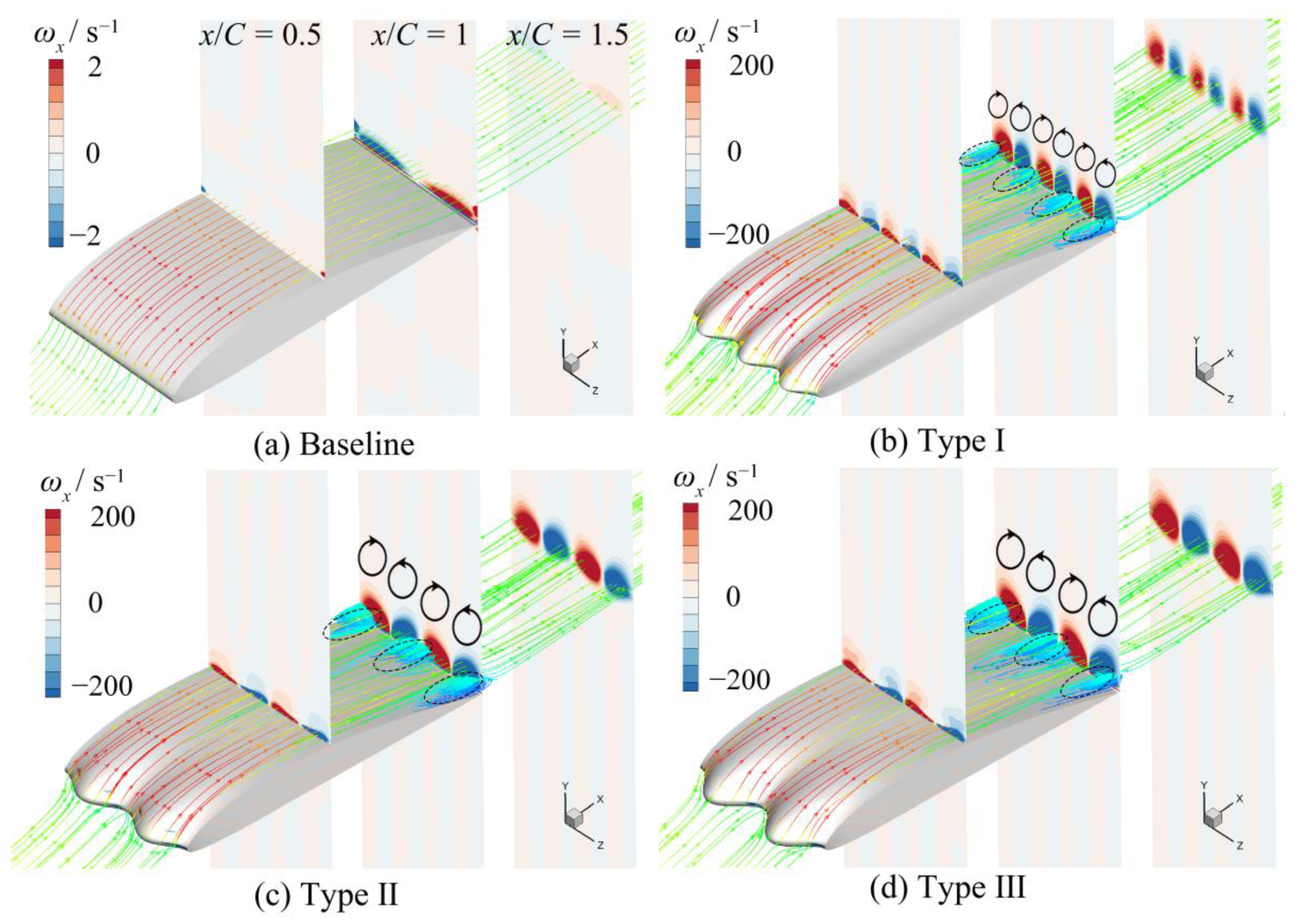


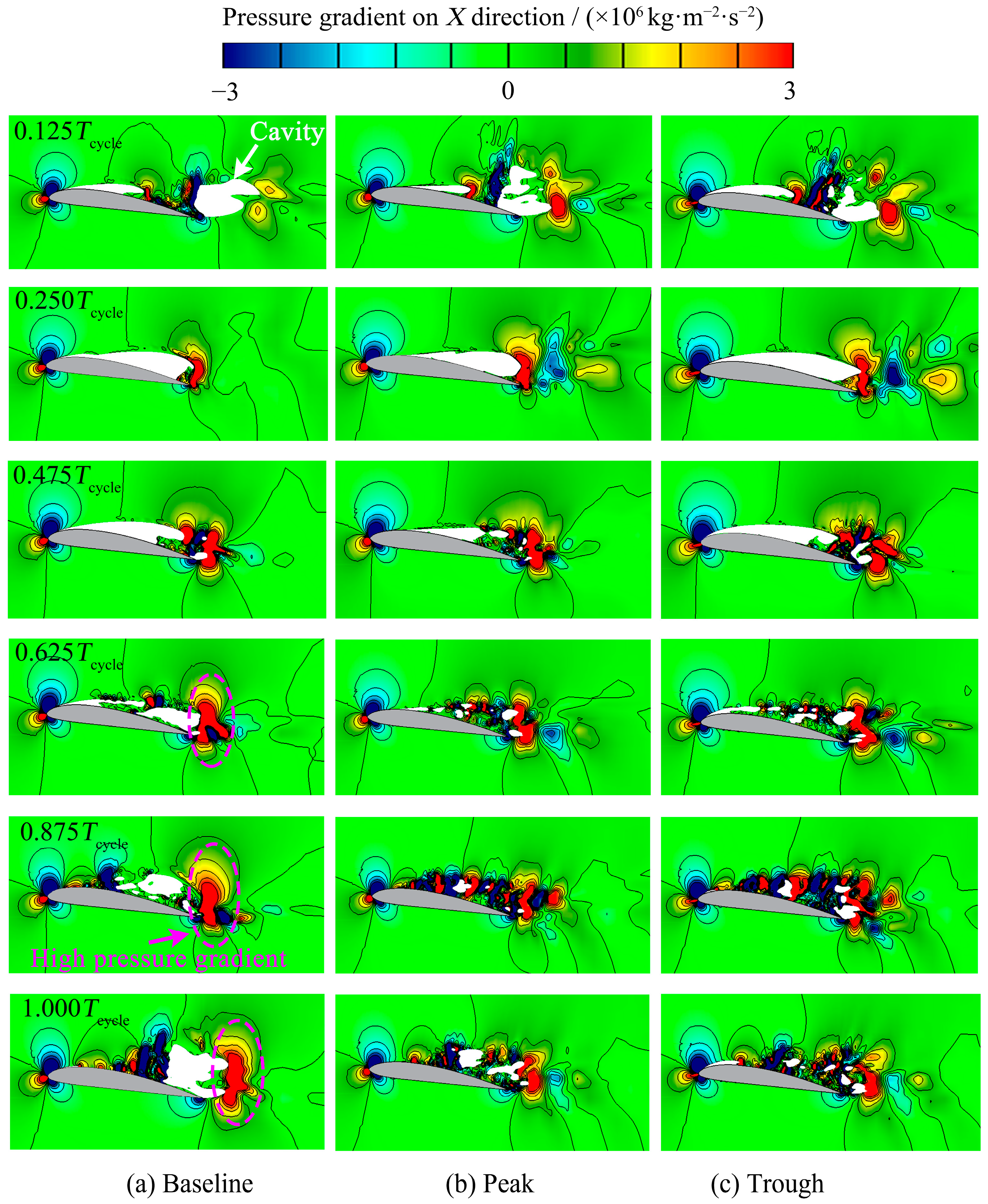
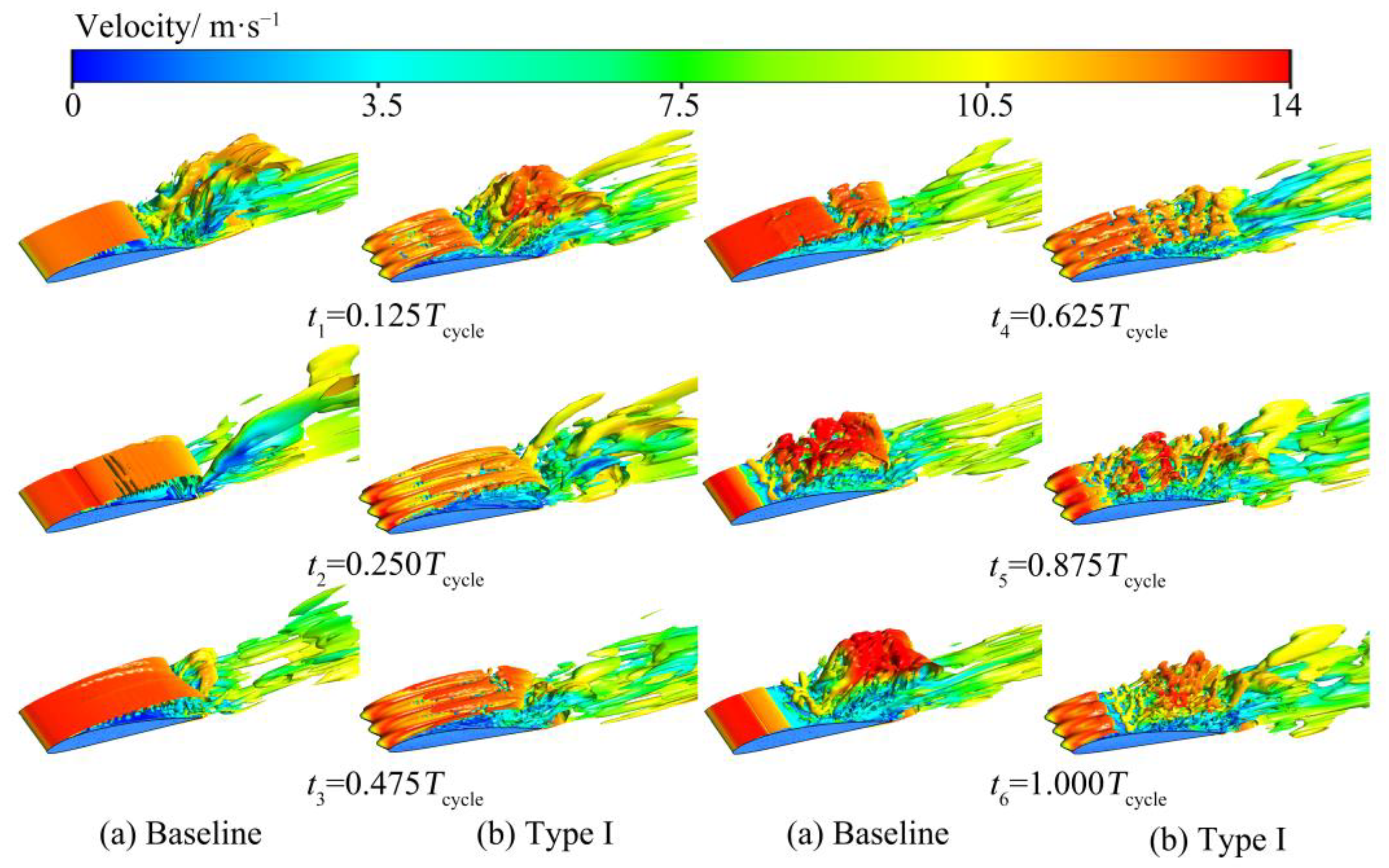
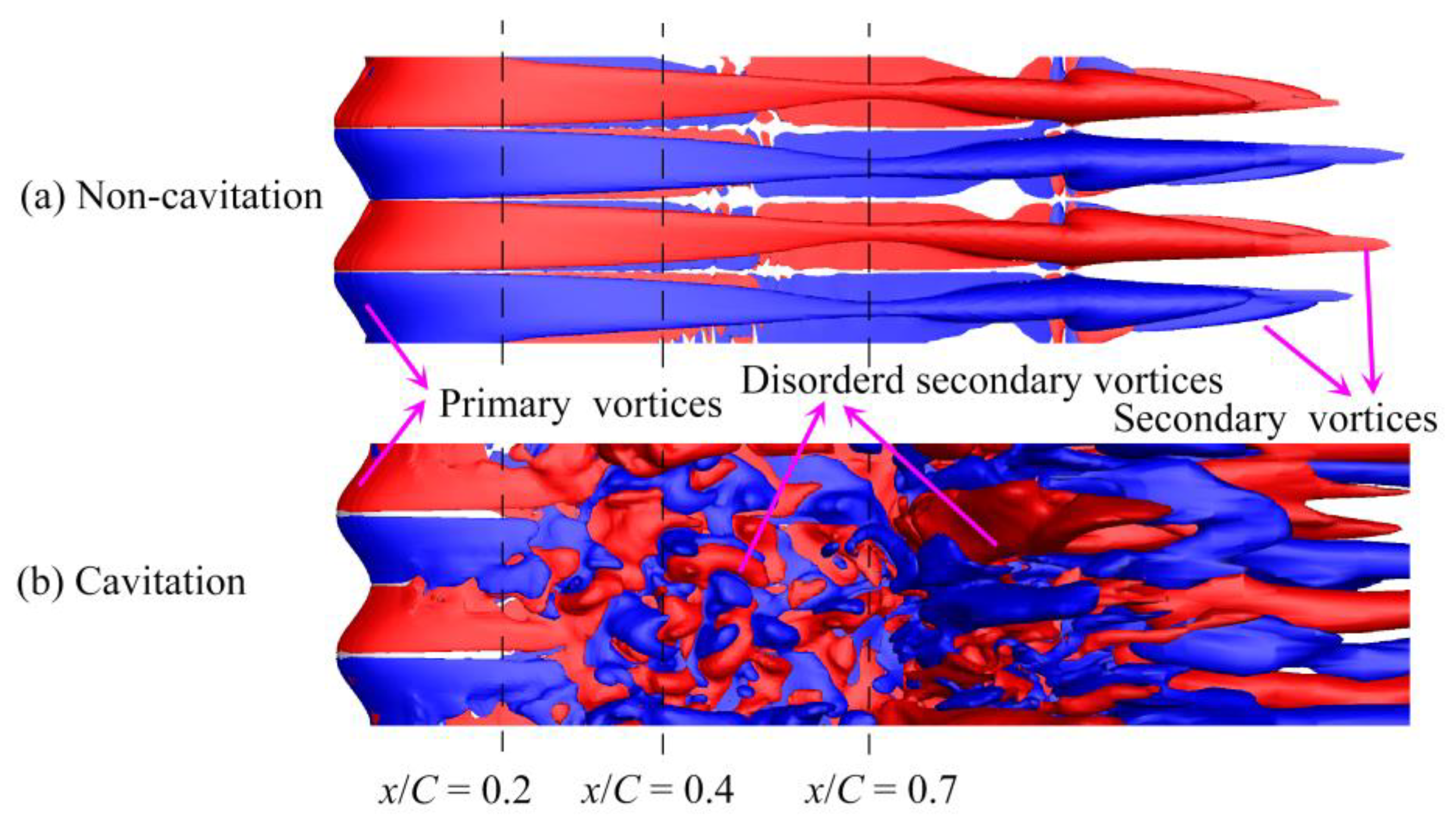


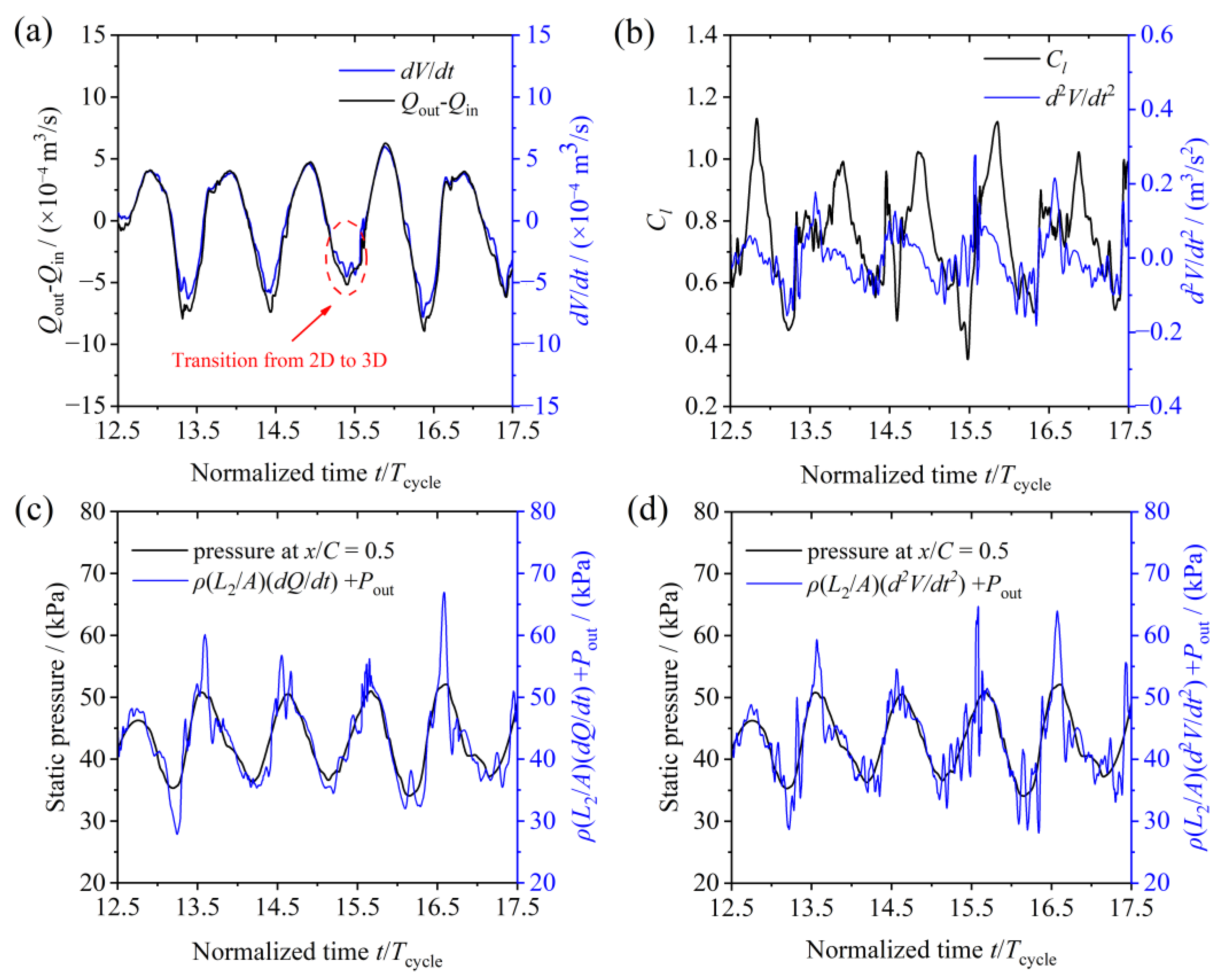
| Variables | Baseline | Type I | Type II | Type III | |||||
|---|---|---|---|---|---|---|---|---|---|
| Grid | Elements (million) | Cl | GCI (%) | Cl | GCI (%) | Cl | GCI (%) | Cl | GCI (%) |
| Coarse | 0.479 | 1.215 | CGIfine = 0.044 CGImedium = 2.638 | 1.097 | CGIfine = 0.000 CGImedium = 0.266 | 1.106 | CGIfine = 0.057 CGImedium = 0.787 | 1.097 | CGIfine = 0.000 CGImedium = 0.011 |
| General | 0.958 | 1.201 | 1.099 | 1.123 | 1.111 | ||||
| Medium | 1.915 | 1.191 | 1.112 | 1.131 | 1.108 | ||||
| Fine | 2.874 | 1.190 | 1.112 | 1.130 | 1.108 | ||||
Publisher’s Note: MDPI stays neutral with regard to jurisdictional claims in published maps and institutional affiliations. |
© 2021 by the authors. Licensee MDPI, Basel, Switzerland. This article is an open access article distributed under the terms and conditions of the Creative Commons Attribution (CC BY) license (https://creativecommons.org/licenses/by/4.0/).
Share and Cite
Li, J.; Liu, C.; Li, X. Effects of Wavy Leading-Edge Protuberance on Hydrofoil Performance and Its Flow Mechanism. J. Mar. Sci. Eng. 2021, 9, 1138. https://doi.org/10.3390/jmse9101138
Li J, Liu C, Li X. Effects of Wavy Leading-Edge Protuberance on Hydrofoil Performance and Its Flow Mechanism. Journal of Marine Science and Engineering. 2021; 9(10):1138. https://doi.org/10.3390/jmse9101138
Chicago/Turabian StyleLi, Jing, Chunbao Liu, and Xiaoying Li. 2021. "Effects of Wavy Leading-Edge Protuberance on Hydrofoil Performance and Its Flow Mechanism" Journal of Marine Science and Engineering 9, no. 10: 1138. https://doi.org/10.3390/jmse9101138




